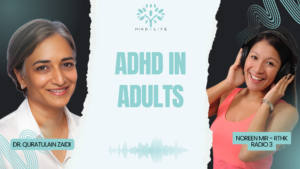Trauma is an experience we go through when we are faced with an event that is deeply distressing and overwhelms our coping abilities. This experience occurs at four levels: cognitive, emotional, physiological, and behavioural. More specifically, if we are dealing with a sudden threat to our wellbeing, we may think we are going to die (cognitive), feel intense fear (emotional), have our heart beating out of our chest (physiological), and set off to run as far away from danger as possible (behavioural).
During a traumatic event, our sympathetic nervous system is triggered. This system is responsible for preparing our bodies for optimal functioning that will give us the best chance of survival. As a result, we may experience physical symptoms, such as an increased heartrate, the rush of adrenaline, sweating, trembling, restlessness, and shallow breathing. During this time, the communication between the emotion centres and higher cortical areas of our brain may go offline, and we are primarily driven by intense survival emotions. Our thoughts may feel foggy or racing, somewhat difficult to grasp. Our behaviours may feel automatic or instinctive. They tend to fall into three categories: fight, flight, or freeze. Fight or flight is engaged when the brain makes a heuristic calculation that approaching the danger to fight or withdrawing from the danger to flee are our best chance at survival. Freeze typically occurs when the calculation indicates that there is no chance for survival. Our system begins to shut down, we may feel unable to move or think, and we may experience a sense of detachment.
Both Big T Trauma and little t trauma can activate this survival mechanism. Big T Trauma is the type most commonly associated with trauma, namely being faced with or witnessing serious injury, potential death, and sexual assault – physical threats to our survival or the survival of others. This can include severe accidents, attacks, conflict zones, emergency rooms, or natural disasters. Little t trauma, on the other hand, can be experienced in response to any highly distressing incident, even if it does not represent an immediate threat to our life. This can include emotional and physical abuse, bullying, neglect, divorce, or rejection.
Both Big T and little t trauma can have significant and pervasive negative impact on our wellbeing, our relationships, and our overall functioning. If the traumatic event is not fully processed, residual trauma may continue to affect us even decades after the incident. For trauma to be resolved in a healthy way, all four levels of the traumatic experience need to be addressed. For example, working on changing our thoughts about what happened or making behavioural changes can help us shift some negative beliefs that stem from the traumatic event and make us feel more in control. However, we cannot merely ‘think or act our way out of trauma’. To fully process our experience, we need to also work with its emotional and physiological aspects. Therapy can be essential in helping us resolve trauma at all four levels and integrate the experience in a way that enables growth and healing, rather than being a destructive influence on our lives and wellbeing.







